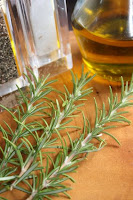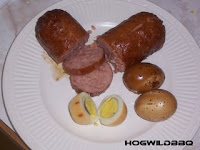 sil twigs as a nice addition to the smoker to add that “extra something” to your grilled meat. Here’s another barbecue trick.
sil twigs as a nice addition to the smoker to add that “extra something” to your grilled meat. Here’s another barbecue trick.
BBQ Tips and Tricks
 sil twigs as a nice addition to the smoker to add that “extra something” to your grilled meat. Here’s another barbecue trick.
sil twigs as a nice addition to the smoker to add that “extra something” to your grilled meat. Here’s another barbecue trick.
A smoke ring is often thought to be a sign of barbecue perfection. It’s a coveted low and slow cooking phenomenon that looks like a luscious pink edge that boarders the outside border of the meat. It’s vital to competition pulled pork and especially beef brisket. Pit Masters use it as a sign of true craftsmanship but you can achieve this mark of cooking success too.
The smoke ring by itself will not enhance the flavor of your meat. It is not smoke flavor soaking into the meat. It is, in fact, a mark made by a chemical reaction. When nitric acid is absorbed back into the surface of the meat it changes the color of the flesh. Nitrogen dioxide comes from the natural wood smoke and combines with the wet surface of the meat to create this reaction.
Some people say cooking with green or water soaked wood will enhance the color of the ring. Others insist you must put the meat on the grill or smoker while it is still cold and fresh from the refrigerator to get a better ring. One competition team actually fakes the smoke ring by painting the edge of the meat strategically with sauce!
One of the most common ways to “hack” a barbecue smoke ring is by using a curing solution like Morton’s Tender Quick. The package reads, “Tender Quick is a blend of the finest quality salt, sugar and meat curing ingredients. It is perfectly blended for fast cure action and improved flavor and color of the meats.” The secret is that it contains the sodium nitrate/nitrite that you can use to make your smoke ring with no smoke at all. It’s the kind of stuff that makes cured ham pink.
Add some Tender Quick to a rub or dissolve it in a brine and you will see an immediate difference in your meat’s smoke ring. Many competitive cookers will also use products referred to as “pink salt,” Prague Powder or Fab (a meat enhancer).
A spoonful of Tender Quick mixed into your rub before coating the meat should do the trick. For an extreme smoke ring some cooks rub the meat with Tender Quick and then let the meat set for an hour before rinsing and cooking. Use caution with the amount of Tender Quick you use on you meat. You don’t want to end up with corned beef or cured ham.
There are many ways to manufacture a smoke ring on your barbecue but remember using a chemical nitrate like Tender Quick will not add any smoke flavor and that is the true hallmark of great barbecue. Visit Barbecue Tricks to discover more tips to enhance your outdoor cooking.
To a lot of foodies and backyard cookers “barbecue” means “smoke kissed” meat. The succulent and flavorful meat just isn’t quite right without a lick of Hickory (in the South) or a hint of Mesquite (in Texas) or even flavors of whiskey barrel Oak (ala Lynchburg, TN). Smoke flavor in grilling and barbecue isn’t too hard to achieve. You don’t need a huge wood stoked smoker on a trailer like the super serious competition teams or even a specially built upright smoker. The only thing you really need is real hardwood.
Hardwood chips or chunks for barbecue are fairly easy to find. Watch the country roadsides to buy good dry wood in full logs or split. Wood chunks – about the size of a lemon – can be found in outdoor and cooking centers. And smoking wood chips can be found bagged in many supermarkets right along side of the charcoal. When buying make sure the wood is nice and dry and with little bark attached (bark and insects can emit unpredictable scents).
If you don’t have a true smoker you can still add that real smoke flavor to your outdoor gas grilled foods. Smoker boxes are made to contain about a fist full of your favorite wood chips. The box controls the intake of oxygen to help keep the wood from burning too fast and, instead, smolder with a slow stream of flavorful smoke lofting up to the meat. The boxes come in lots of shapes and sizes. Some are even triangular to set nicely inbetween grill grates or wedge next to a gas burner. Most all smoker boxes are short enough to fit UNDER grill grates to set next to or on top of gas burners. Place the meat directly in line with flow of smoke (usually between the box and an open chimney).
The smoker boxes are an inexpensive addition to a gas grill and can also be used in charcoal grills to keep floating ashes down off the meat.
If you are looking to buy a smoker box look for the most solid construction you can find. Ideally a cast iron box will last the longest in the high heat and corrosion. Pit masters will bigger grills sometimes resort to using cast iron pans for long term chip boxes.
If you are only adding occasional smoke in your back yard gas grill you can easily achieve great results by constructing a simple “smoker pouch” out of heavy (or double layer) aluminum foil. Simply fold the foil into a makeshift envelope, add chips of your liking, and fold to seal tight. Poke just a few air holes into the foil to release the smoke and then set the pack under the grill grate and on top of the burner. For longer cooking time (like four hour ribs) you can have a second or even third “smoke bomb” set aside from the start to quickly toss under the grate after the first pouch smokes out. Discard the pouches when the grill is fully cooled. You could even soak half the chips in water to slow down the smoking process. BBQ masters will typically soak wood chips and chucks for at least 30 minutes before they put coals directly on hot charcoal to allow for a smolder instead of a sooty hot fast burn.
Wood chips and a smoker pouches can really help make your next batch of home cooked barbecue taste like the competition champ’s. Experiment with wood varieties like hickory, apple wood, mesquite, and cherry. Avoid pine and resin heavy woods that can leave off flavors and never use pressure treated lumber that could give of toxic fumes. See our Wood Smoking Guide HERE.
That name may be a bit confusing… beef Brisket has always been a Texas thing. Mesquite, slow slow smoked, a tradition down there.
Here’s a Barbecue Tricks version of the brisket that tastes great with HICKORY smoke and a bit of sweet heat to give it a southern twist.
We used a Brinkmann Gourmet Electric smoker that keeps the smoker a low 225 degrees and also used a combination of chunk and chipped hickory for smoke.
Brisket is an all day affair… so using a true smoker (with a good drip pan) will really save you some peace of mind. Electric smokers are offensive to purists (no charcoal?!) but if you keep it smoking with pre-soaked wood chips (in a foil pouch) you can’t tell the difference.
Start the night/day before by separating the FLAT portion of the brisket from the tip. Trim away most of the excess fat (down to about 1/4 of an inch covering the flat). This will cut the cooking time way down and give you more smokey surface area. Continue by rinsing clean and rubbing a 5 to 10 pound brisket with a simple RUB. Wrap with plastic wrap and refrigerate until morning. It should “cure” 4-12 hours for best results.
Give yourself extra time for the smoker and restrain yourself from lifting the dome lid more than you absolutely have to. Lifting the dome lid will add at least a half hour to the entire process every time you release the already low heat. Hopefully the smoker has a side door to replenish chips and drip pan liquid.
Remove your meat, unwrap and allow to slowly come to room temperature (about an hour). Start your smoker and give it 40 minutes to heat up.
Place the meat – fat side up – over the drip pan to avoid messy drips.
After smoking 5 or 6 hours we enlisted our Barbecue Trick: sprinkle the brisket liberally with brown sugar and paprika. Place it upside down (fat side down) on aluminum foil and coat the other side. Check the internal temperature. Wrap tightly with foil and put back on the smoker.
The entire smoking process will vary but our Flat cut was finished (internal thermometer to 190 degrees ) in about eleven hours (opening the lid only once). The Point cut took an additional 2 hours to get to internal 190 degrees (the lid was often opened for testing).
One you remove from the smoker you STILL will want to wait another 40 minutes to allow the meat to rest and retain coveted juices. Remember YOU NEED TO ALLOW A LOT OF TIME for this entire process. Back time from meal time and make sure to include an hour for “heating up the smoker” and getting the chill off the meat. Plus another hour for the final “rest”.
It’s an all day affair. Our tested brisket started as a 10.5 lbs piece of meat but when the flay was separated it was two approximately 5 lbs. pieces. Flat took eleven hours on the smoker. The point was thicker and a bit bigger and took thirteen.
It’s also important to note that -IF YOU CAN WAIT- some say it’s best to refrigerate and re-heat the next day for the best results (good luck with that waiting!)
 Gotta hand it to the Hogwild Barbecue Blog…
Gotta hand it to the Hogwild Barbecue Blog…
They came up with a cool idea for smoking an egg.
Whole. Un-cracked.
They smoked it extra low – about 160 degrees for about an hour.And even that they say may be a bit over done. The smoke really DOES penetrate the shell too.They say if you like hardboiled eggs you’re sure to dig this trick. Imagine THAT kicking up your deviled eggs!
Posts on this site may contain affiliate links. If you purchase something via one of these links you won’t pay more but the site operator gets a small commission. Or as I like to call it: “beer money.”